by Jena | Apr 24, 2016 | BK virus, Dialysis, Infectious Disease, Stem Cell Transplant |
Day +19, Thursday, April 21, 2016
WBC: 1.43 k/uL LOW H: 8.5 g/dL LOW P: 18 k/uL LOW BUN: 83 HIGH Cr: 4.3 CRITICAL Na+: 150 HIGH
Mentation. Dad was alert when Dr. Ochoa-Bayona, inservice BMT, visited. He oriented to person, place, and time, but he closed his eyes during conversations. Dad was mildly confused when Dr. Baluch, BMT infectious disease, visited.
Blood. Repeated testing for BK virus. Got D5 water IV.
Mouth and Throat. Dad requested ice chips, but was still not permitted due to aspiration risk.
Lungs. Dad continued to breathe on his own. He continued to cough and have thick secretions from the mucositis.
Abdomen. Diarrhea continued. Dad’s feeding was still suspended due to the diarrhea.
Kidneys. Urine output improved again. Saw a slight increase in creatine (Cr). Monitored sodium (Na+). Urine culture conducted.
Day +20, Friday, April 22, 2016
WBC: 2.34 k/uL LOW H: 8.2 g/dL LOW P: 14 k/uL LOW BUN: 85 HIGH Cr: 4.8 CRITICAL Na+: 148 HIGH
Mentation. When Dr. Ochoa-Bayona, inservice BMT, visited in the morning, he found Dad to be more confused than the previous day. Dad could only orient to a person. Dad didn’t know where he was nor the date. He was slurring his speech. Dad remained in a confused state when Dr. Chemaly, nephrology, visited midday. Dad would only repeat back what Dr. Chemaly said. When Dr. Baluch, BMT infectious disease, came by in the evening, she felt that Dad had worsened confusion.
An EEG was performed, which tested Dad’s cerebral function. The result was abnormal and initially suggested nonspecific moderate to severe brain malfunction. No seizure activity was observed during the study. Dad’s case was reevaluated and noted that Dad had experienced acute renal (kidney) failure, BUN level was high at 85, and creatine (Cr) was trending down.
A CT scan of Dad’s brain indicated no acute cerebral lesions but did show that Dad’s sinuses were irritated and inflamed.
An MRI of Dad’s brain showed no acute changes. The MRI ruled out stroke and abscess.
Dad’s mental state to be pursued as caused by infection, toxins or metabolic problems. Dr. Chemaly believed that Dad’s mental state was unlikely due to uremia, a condition involving abnormally high levels of waste products in Dad’s blood.
Dr. Ochoa-Bayona withheld narcotics and sedatives.
Blood. Increased D5 water IV.
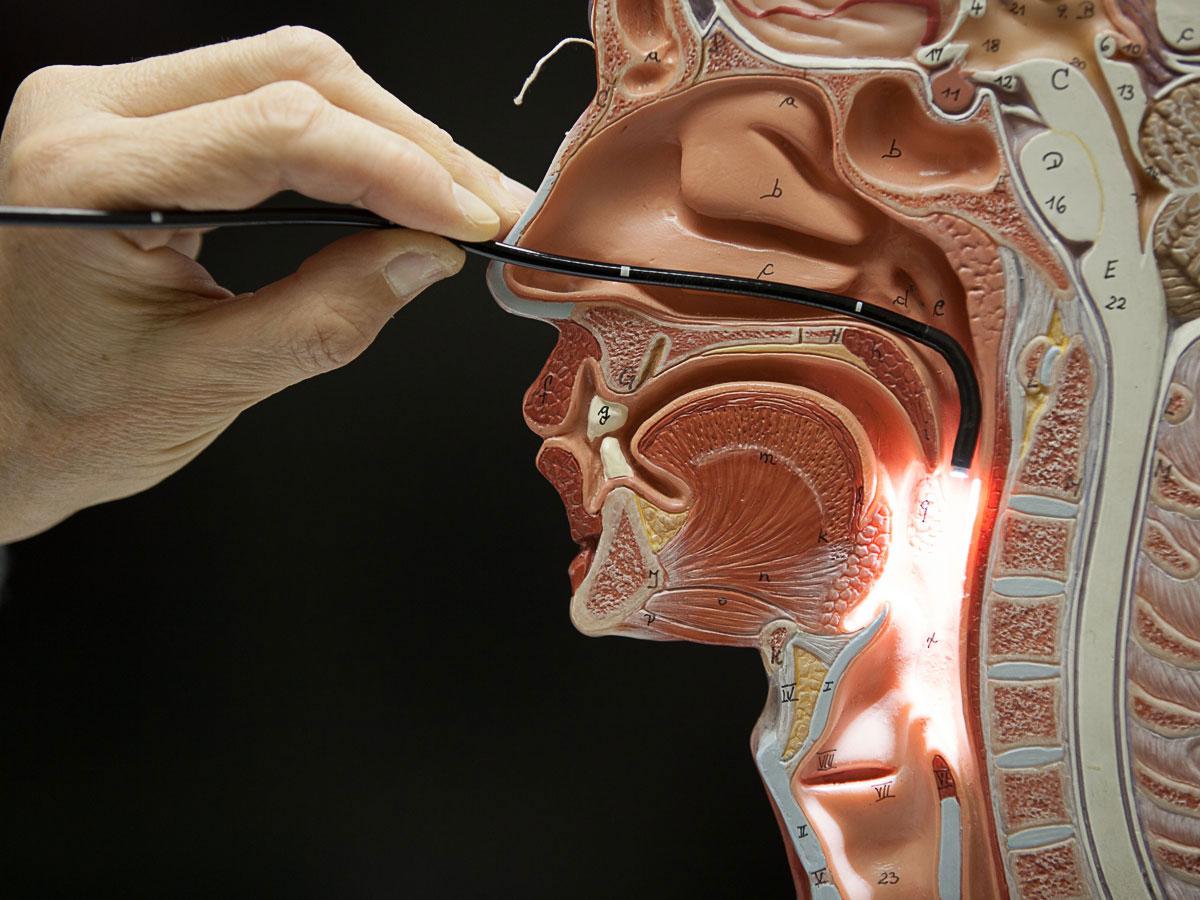 Mouth and Throat. Based upon the result of the CT scan of Dad’s brain, ENT (ear, nose & throat) was consulted to check for fungal sinusitis. ENT performed a bedside Flexible Nasal Endoscopy, which showed no evidence of a fungal infection. It did show a clear, runny nose. ENT recommended continued IV antibiotics for viral and bacterial sinusitis.
Mouth and Throat. Based upon the result of the CT scan of Dad’s brain, ENT (ear, nose & throat) was consulted to check for fungal sinusitis. ENT performed a bedside Flexible Nasal Endoscopy, which showed no evidence of a fungal infection. It did show a clear, runny nose. ENT recommended continued IV antibiotics for viral and bacterial sinusitis.
Lungs. Dad was placed back on supplemental oxygen at 2L. He continued to cough and have thick secretions from the mucositis.
Abdomen. Dad’s feeding was still suspended.
Kidney. Dad’s urine output continued to improve and no longer contained blood. Dr. Chemaly, nephrology, wanted to avoid dialysis given the possibility of an ischemic stroke, which occurs as a result of an obstruction within a blood vessel supplying blood to the brain.
by Jena | Apr 17, 2016 | Atrial Fibrillation, BK virus, Dialysis, Graft-versus-host-disease (GvHD), Infectious Disease, Meropenem, Minocycline, MRSA, Sepsis, Sirolimus, Stem Cell Transplant, Zosyn |
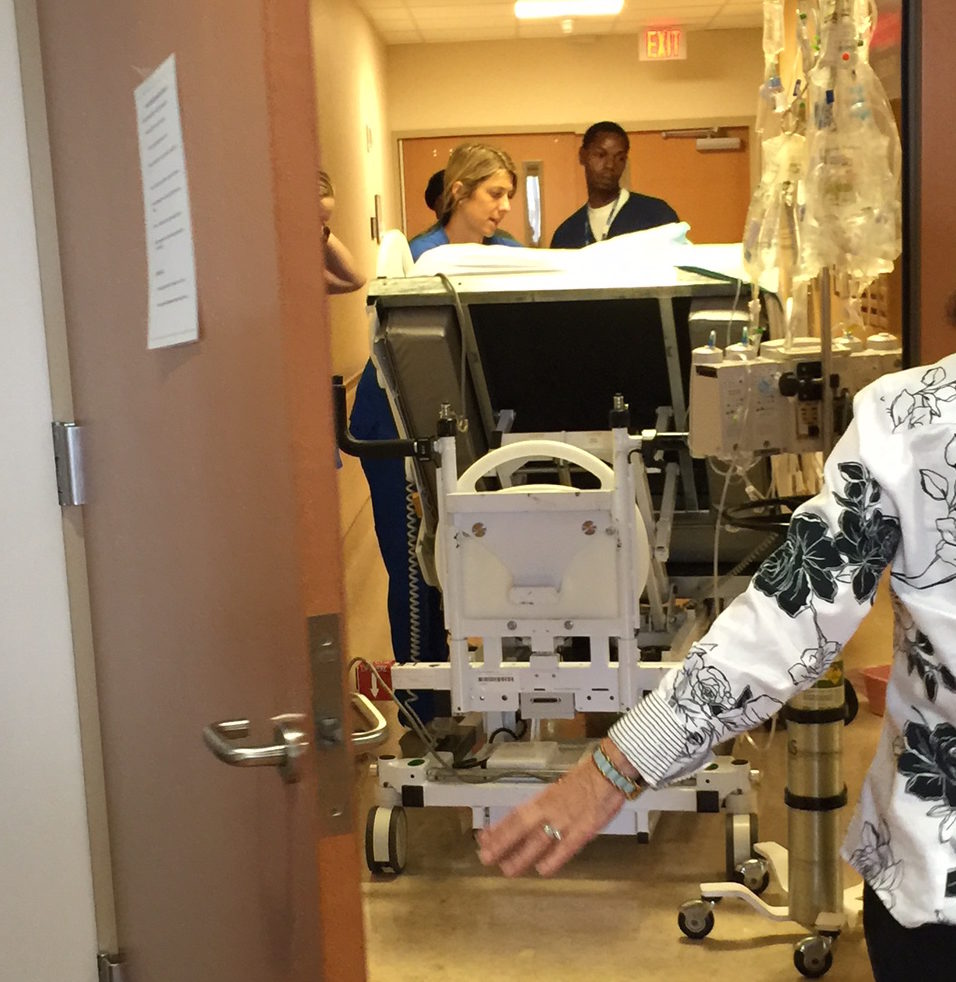 Dad was moved to the ICU on the second floor.
Dad was moved to the ICU on the second floor.
Day +13, Friday, April 15th.
WBC: 0.08 k/uL CRITICAL H: 7.4 g/dL LOW P: 18 k/uL LOW Cr: 3.9 HIGH Na+: 148 HIGH
Blood. All three lines (blue, red & white) in Dad’s central line catheter indicated Gram-negative bacteria. Continued minocycline for MRSA and atypical Gram-negative bacteria.
Dad continued to receive blood support (platelet and blood transfusions & neupogen shots) as needed.
Graft versus host disease (GvHD). Dad was unable to take sirolimus since he was restricted from all food and drink.
Mouth & Throat. Dad continued to have pain from mucositis and used magic mouthwash to treat.
Heart. The day before’s echo cardiogram confirmed no heart failure.
Lungs. Dad continued his liquid diet. Again, anytime he drank, he would go into a terrible coughing fit and would require use of an oral suction/vacuum. It was determined that Dad’s epiglottis was not closing properly to prevent food and drink from entering his larynx down to his lungs. The day before’s two chest X-rays showed developing aspiration pneumonia.
Dad had another X-ray taken of his chest. Continued supplemental oxygen. Ordered a nasal feeding tube, but the nurse, who specializes in feeding tube insertions, was unsuccessful in placing Dad’s tube after several attempts.
Abdomen. The day before’s abdomen X-ray showed mild improvement. Imodium was stopped. Dad was switched from Zosyn to meropenem, an ultra-broad spectrum antibiotic.
Kidneys. Nephrology discussed with us the possibility of Dad needing dialysis. The day before’s renal ultrasound showed swelling of Dad’s right kidney due to a possible obstruction. Repeated ultrasound. BK virus was finally confirmed as the source of blood in Dad’s urine. Continued IV fluids and monitored sodium levels. Nephrology also monitored potassium in Dad’s blood and identified Dad as having hypokalemia (deficiency of potassium in the bloodstream). Dad was considered anuric (not passing urine).
Legs. An ultrasound of Dad’s legs, taken the night before, confirmed no blood clots.
by Jena | Apr 17, 2016 | Atrial Fibrillation, Graft-versus-host-disease (GvHD), Infectious Disease, Sepsis, Sirolimus, Stem Cell Transplant, Tobramycin, Vancomycin, Zosyn |
Dad has declined dramatically.
Day +12, Thursday, April 14th.
WBC: <0.01 k/uL CRITICAL H: 7.0 g/dL LOW P: 21 k/uL LOW
Blood. Everyday, Dad’s 3 lumens (blue, red & white) of his central line catheter are tested. The day’s initial blue line test indicated Gram-negative bacteria. Dad was given tobramycin, an antibiotic, to treat. Further testing on the blue line resulted in Dr. Baluch, BMT infectious disease, stopping vancomysin and starting minocycline, another broad spectrum antibiotic.
Dad continued to receive blood support (platelet and blood transfusions & neupogen shots) as needed. Set targets for hemoglobin (H > 8) and platelets (P > 20).
Graft versus host disease (GvHD). Dad continued to take sirolimus to prevent GvHD.
Mouth & Throat. Dad continued to have pain from mucositis. Used magic mouthwash and oxycodone to treat.
Heart. Continued oral Amiodarone to manage atrial fibrillation.
Lungs. Dad had another X-ray of his chest. Continued supplemental oxygen.
Dad was still on a liquid diet. Anytime he drank, he would go into a terrible coughing fit and would require use of an oral suction/vacuum.
Abdomen. Dad continued with Imodium to treat diarrhea. He had another X-ray of his abdomen taken. Dad continued to receive Zosyn as broad spectrum antibiotic.
Kidneys. Creatine (Cr) is the most widely used marker of kidney function in patients undergoing stem cell transplant. Measure of creatine provides an estimation of renal function allows for following trends in renal function. We have learned that acute and chronic kidney disease are common following stem cell transplant and can lead to long-term effects. Stem-cell-transplant-associated kidney injury are often due to a variety of factors including conditioning chemotherapy and sepsis.
Nephrology (kidney doctors) was consulted. Dr. Khimani, inservice Blood & Marrow Transplant (BMT), noted that Dad’s urine output decreased in the prior 24 hours with increased creatine (Cr: 2.3 HIGH). Dad’s sodium also continued to increase (Na: 150 HIGH), which was noted as hypernatremia. Dad continued to receive fluids and have his sodium levels monitored. Dad had a renal ultrasound. Dad was having acute renal failure. He was in septic shock (widespread infection causing organ failure and dangerously low blood pressure) and cardiogenic shock (his heart was unable to pump enough blood to his organs to meet his body’s needs).
Dad was moved to intensive care status. Dr. Baluch, BMT infectious disease, believed that Dad should be transferred out of the BMT unit on the third floor to the intensive care unit (ICU) on the second floor.
by Jena | Apr 17, 2016 | Atrial Fibrillation, BK virus, Epstein-Barr virus (EBV), Folotyn, Ileus, Infectious Disease, Lasix, MRSA, Rituximab, Stem Cell Transplant, Vancomycin, Zosyn |
Catching you up from last Saturday to Wednesday…
Day +7, Saturday, April 9th.
WBC: 0.03 k/uL CRITICAL H: 7.3 g/dL LOW P: 16 k/uL LOW
Dad had continued to go in and out of atrial fibrillation. By the evening, his heart was in normal sinus rhythm (NSR). Dad felt that his abdomen had improved.
Dad noticed increasing throat pain with swallowing. Oral mucositis (mouth sores) can be extremely painful and can result in an inability to eat, speak, or swallow. Last summer, when Dad had received Folotyn (pralatrexate) chemotherapy, he had suffered from oral mucositis. Dad had used magic mouthwash to get some relief. Magic mouthwash is the term given to a solution used to treat oral mucositis.
Abdominal fluid retention improved slightly. Dad had an abdominal X-ray taken.
His diarrhea remained improved. He remained fever free. He remained on 2 L/min oxygen.
MRSA was confirmed on April 6th once Staphylococcus was identified on April 5th.
Day +8, Sunday, April 10th.
WBC: 0.01 k/uL CRITICAL H: 7.3 g/dL LOW P: 13 k/uL LOW
Report from the day before’s abdominal X-ray showed mildly prominent loops in his small intestine, which possibly represented ileus or enteritis. Ileus is the inability of the intestine to contract normally and move waste out of the body. Enteritis is inflammation of the intestine usually accompanied with diarrhea. Dad’s diet was downgraded to clear liquids. His abdominal swelling was improved, yet he continued to receive lasix, a diuretic, to address the fluid retention.
Dad had an X-ray of his chest taken. He was breathing on his own.
Dad switched to an oral amiodarone to manage his atrial fibrillation.
He continued to be monitored for EBV (Epstein-Barr virus), which is more commonly known as mononucleosis or “mono.” Most people will be infected with EBV in their lifetime and will not have any symptoms since it is controlled by a healthy immune system. Yet, when someone has a weakened immune system, the EBV infection can get out of control.
Day +9, Monday, April 11th.
WBC: 0.04 k/uL CRITICAL H: 8.2 g/dL LOW P: 5 k/uL CRIT
The prior day’s chest X-ray suggested inflammation in Dad’s lungs versus fluid overload. Dad’s respiratory culture showed both “gram-positive” and “gram-negative.” These are terms used to classify bacteria into two groups. Usually, gram-positive bacteria are helpful, and gram-negative are the ones that cause illness.
Dad’s atrial fibrillation continued to be addressed with the oral amiodarone. He continued to receive lasix, a diuretic, to address the fluid retention. Dad remained on a clear liquid diet.
The blood in Dad’s urine was suspected to be the BK virus and adenovirus. For most, the BK virus has no consequences since it remains latent, but it can be reactivated during post stem cell transplant when immunosuppressed.
Dad was too tired to work with physical therapy.
Day +10, Tuesday, April 12th.
WBC: 0.02 k/uL CRITICAL H: 8.2 g/dL LOW P: 7 k/uL CRIT
Dad started to choke/cough when eating ice or drinking liquids. Yet, Dad said that his cough had improved and was no longer producing sputum, which is a mixture of saliva and mucus. Respiratory culture from the day before likely indicated MRSA.
Dad’s sodium was high at 148 mmol/L..
Day +11, Wednesday, April 13th.
WBC: 0.01 k/uL CRITICAL H: 8.0 g/dL LOW P: 12 k/uL LOW
Dad continued to be monitored for EBV. Based upon the latest EBV test results, Dr. Ayala, Dad’s primary BMT doctor, was consulted. It was determined that Dad would receive an infusion of rituximab. Rituximab is used to treat EBV post stem cell transplant. Since Dad experienced rigors, fatigue and mild confusion in the morning, the rituximab treatment was postponed.
Dad complained of further pain in his mouth and throat. Dad continued to take oxycodone and magic mouthwash to provide relief from the mucositis. Two X-rays were taken (chest and abdomen). Dad restarted supplemental oxygen.
His cultures indicated MRSA. Dad was started on two new antibiotics, vancomycin and Zosyn (piperacillin/tazobactam). Vancomycin is used to treat infection of the intestines. Zosyn is the combination of two penicillins.
Dad experienced an abnormal heart rate last night, which was resolved with metoprolol. Dad’s atrial fibrillation continued to be addressed with the oral amiodarone. He continued to receive lasix, a diuretic, to address the fluid retention. Dad remained on a clear liquid diet. Dad had a foley catheter placed since he was at a high fall risk. Dad was given Imodium to treat his diarrhea.
Adenovirus was ruled out as the cause of blood in Dad’s urine. BK virus was still a possibility. Set a goal to maintain Dad’s platelets at 20.
Dad’s sodium was high again at 147 mmol/L. Dr. Baluch, BMT infectious disease, noted that Dad’s T. bilirubin was mildly elevated and wanted to monitor trend.
by Jena | Apr 9, 2016 | Atrial Fibrillation, Cyclophosphamide, Fludarabine, Graft-versus-host-disease (GvHD), Ileus, Infectious Disease, Melphalan, Sirolimus, Stem Cell Transplant |
Today is Day +7. Dad is doing fairly well considering he is in week two, which is one of the worst weeks that stem cell transplant patients endure. He has experienced a variety of issues as expected.
Three blood counts are tracked daily…white blood cell (WBC), hemoglobin (H), and platelets (P). Patients feel the worst as their WBC count plummets to zero, which occurs during week 2.

Here’s a recap since I last posted on Day +2.
Day +3, Tuesday, April 5th.
WBC: 0.13 k/uL CRITICAL H: 7.7 g/dL LOW P: 17 k/uL LOW
Dad was fatigued. He complained that he did not sleep well. He was restless. During the day, Dad was napping frequently to catch up on his missed sleep. Dad continued to have diarrhea, which was attributed to the toxicity of the melphalan (one of his two conditioing chemotherapies received on Day -2). Dad was given Imodium to address the diarrhea.
Dad also received his first of two doses of Cytoxin (cyclophosphamide). Post-transplantation cyclophosphamide (Day +3) prevents acute and chronic GvHD (graft-versus-host-disease).
Dad showed no signs of tremors. Doctors believed it was due to toxicity from the fludarabine chemotherapy, which Dad received on Day – 5 through Day – 2.
Day +4, Wednesday, April 6th.
WBC: 0.08 k/uL CRITICAL H: 7.3 g/dL LOW P: 11 k/uL LOW
Overnight, Dad had spiked a fever of 101.9 and experienced tachycardia (abnormally rapid heart rate). His heart rate went as high as 175 bpm. He was treated with Lopressor (metoprolol) to help abate the tachycardia. Cardiology was consulted, and two electrocardiograms (ECG) were done (12:43 a.m. and 9:14 a.m.). Both ECGs returned similar results of sinus tachycardia (sinus rhythm with an elevated rated of impulses) with premature atrial complexes (APC).
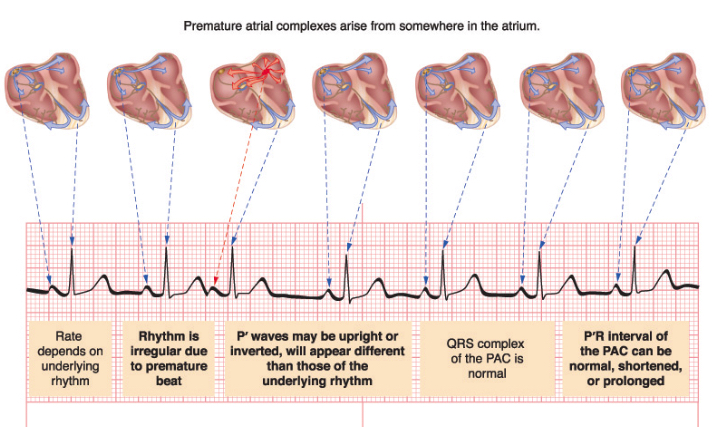
Later mid-afternoon, Dad had an echocardiogram. Dr. Fradley, cardiologist, assessed Dad and concluded that Dad is asymptomatic during these short-lived episodes. He expected that Dad would have arrhythmia due to Dad’s melphalan chemotherapy, which Dad received on Day -2. 12% of patients develop atrial fibrillation from melphalan. He recommended rate control with metoprolol.
Dad had an episode of decreased oxygen saturations. An arterial blood gas (ABG) test was run to measure the acidity (pH) and the levels of oxygen and carbon dioxide in his blood. Dad was put on 3 L/min of oxygen via a nasal cannula.
Dad was also started on Vancomycin via IV to address possible infection in his intestines. Dad continued to have diarrhea and was fatigued. Dad started to note pain in his throat.
Dad was showing signs of fluid retention. He was given two doses of lasix. Dad was having to urinate constantly.
His chest X-ray showed no evidence of pneumonia.
Dad received a platelet transfusion and his second and final dose of Cytoxin (cyclophosphamide).
Day +5, Thursday, April 7th.
WBC: 0.08 k/uL CRITICAL H: 6.6 g/dL LOW P: 16 k/uL LOW
Overnight, Dad went into atrial fibrillation. He was initially given metoprolol via IV. He was then given diltiazem. After Dad experienced low blood pressure and uncontrolled heart rate with diltiazem, he was switched to amiodarone plus digoxin. Dad had another ECG at 8:30 a.m. It was abnormal confirming the atrial fibrillation. Dr. Robinson, cardiology, believed the atrial fibrillation was due to the melphalan chemotherapy, which Dad received on Day -2.
Patients with atrial fibrillation are at greater risk of deep vein thrombosis (DVT). Yet, Dad cannot take an anticoagulant since he is thrombocytopenic (low platetet count).
Dad continued to have diarrhea. He continued to receive Imodium to address. He also continued to receive lasix to address his fluid retention.
Dad complained of tickling of his throat. He was coughing after eating and drinking, thus speech therapy gave him an evaluation. Speech therapy recommended that Dad eat and drink only when sitting up completely. He continued to receive 2 L/min of oxygen.
As planned, Dad was given Rapamune (sirolimus) orally as a prophylaxis against GvHD. He will take sirolimus for 28 days.
Day +6, Friday, April 8th.
WBC: 0.03 k/uL CRITICAL H: 7.2 g/dL LOW P: 14 k/uL LOW
Dad said he received the best night’s sleep he has had in two years. I found that to be quite incredible. The good news was that he was no longer having diarrhea. Dad said his mouth was dry and continued to have discomfort in his throat.
Dad received a platelet transfusion to raise his count from 7 to 14 k/uL.
Late in the morning, Dad finally was up and walking after two to three days of remaining in bed. I brought in a small megaphone for Mom and the physical therapist (PT) to use to encourage Dad to move more. George, the PT, was amused. He had Dad out of bed and moving down the hall with an entourage. Dad was using a walker, and George had a firm grip of the “belt” around Dad’s waist in case Dad fell or collapsed. Dad will have to work himself back up to walking 2 miles a day.

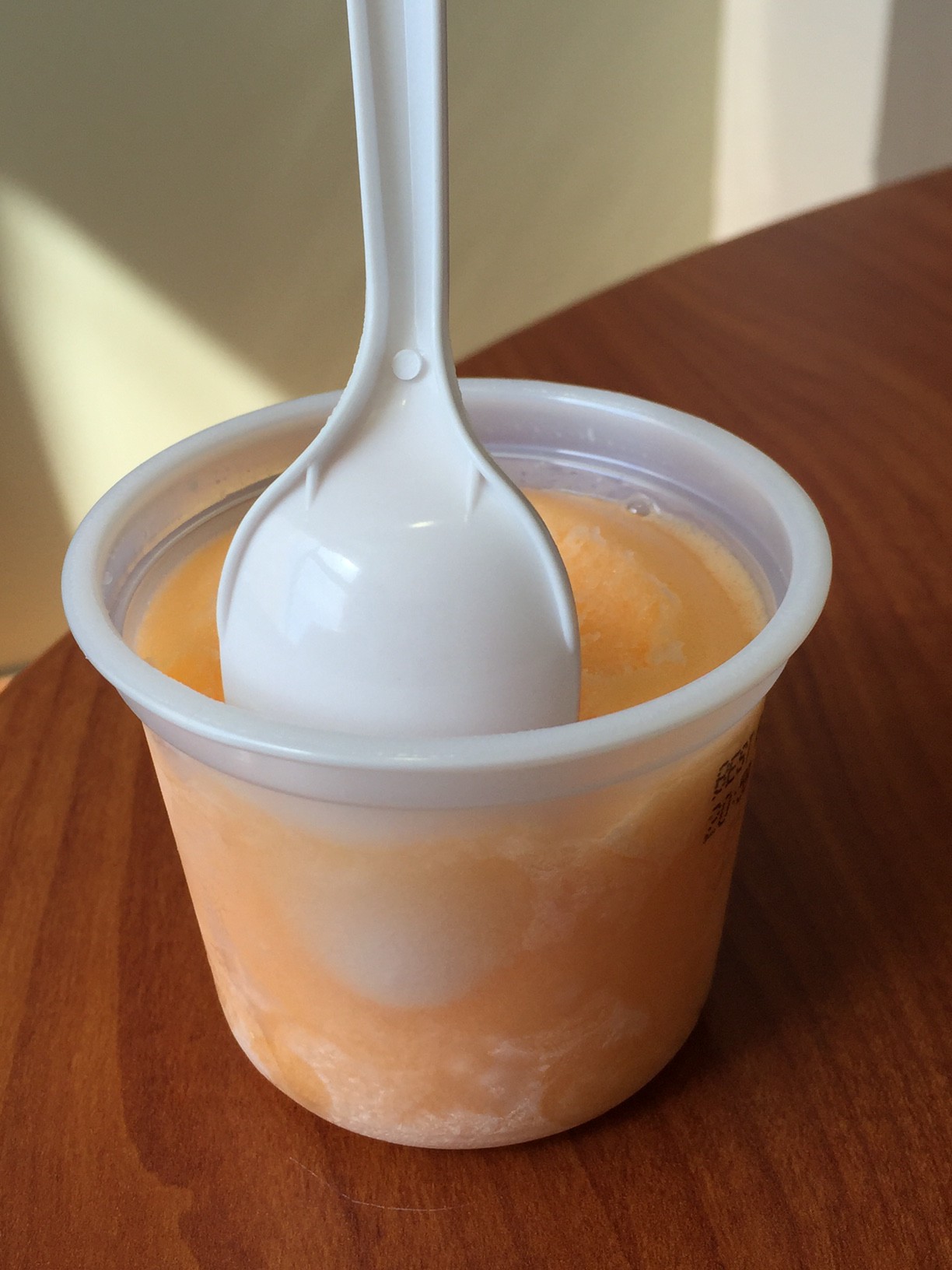
Italian ice is a part of Dad’s new, liquid diet.
Dad had his abdomen X-rayed since it continued to look enlarged. X-ray showed air levels concerning for ileus or obstruction. Patients can develop gastrointestinal (GI) ulcers, vomiting and dairrhea from melphalan. This nasty chemotherapy strips the mucosa of the GI tract. Severe cases can develop ileus or even perforation of the bowel wall. Dad was prescribed Flagyl (metronidazole) as an antibiotic for his abdomen. He was put on a clear liquid diet in order to give his intestines a rest.
Dr. Baluch, BMT (blood & marrow transplant) infectious disease, indicated that Dad would stop receiving vancomycin after today, if he had no more fevers nor positive cultures.
Dad’s urine showed a small amount of blood, but not enough to cause alarm. Another urine analysis to be conducted in one to two days to monitor.
Dad continued to receive lasix to address his fluid retention. He also continued to receive 2 L/min of oxygen.
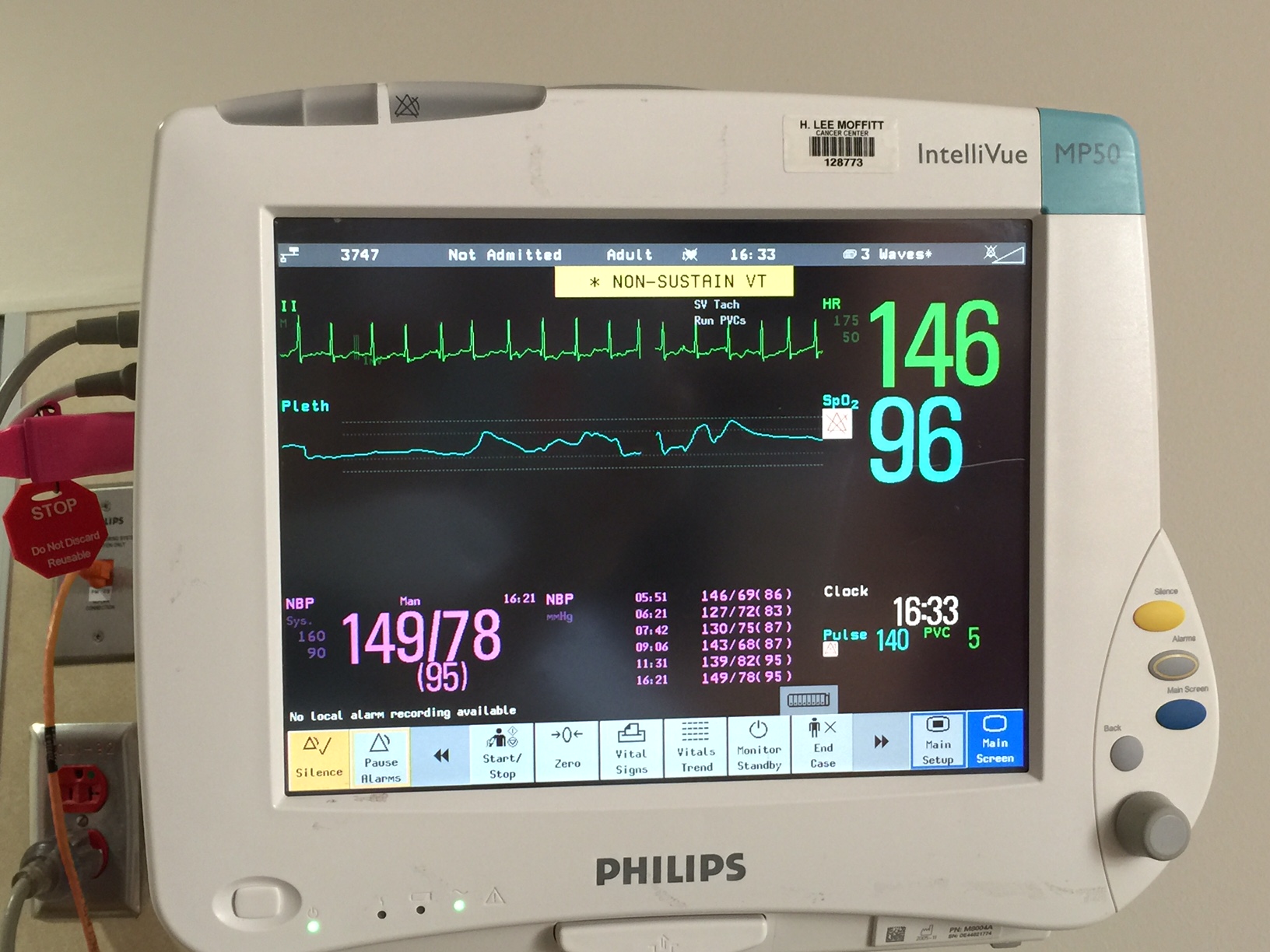
Dad’s heart and oxygen monitor showing 146 bpm.
Late morning, the cardiologist, Dr. Robinson, was thinking that Dad’s heart was improving and had sustained a normal sinus rhythm (NSR). Dr. Robinson had begun to plan how Dad’s heart medications would begin to taper. Unfortunately, Dad’s heart rate was racing again in the afternoon.
by Jena | Mar 31, 2016 | Fludarabine, Infectious Disease, Melphalan, Stem Cell Transplant |
Day -5, Sunday, March 27: Dad got settled into his room in the BMT (blood and marrow transplant) unit on the third floor of the Moffitt Cancer Center. His room is just a few doors down from his prior room in early March. Dad met with Dr. Ochoa, inservice BMT doctor, and Karla Adams, inservice BMT physician assistant. Dr. Ochoa is a jokester, which means that Dad will enjoy his visits with Dr. Ochoa. Karla was extremely friendly, as usual, providing Mom and Dad with hugs.
Mid-afternoon, Dad viewed our church’s Easter service online. Afterwards, Dad received some fluids intravenously (saline).
Dad was slightly pleased with his Moffitt dinner and claimed that it was better than before. After Dad finished dinner, he and Mom walked a mile (11 laps in the BMT unit).
Around 9:00 p.m., Dad started receiving pre-meds for his fludarabine (1st of 4), the conditioning chemotherapy. The earlier plan was for Dad to take steroids as a pre-med for each conditioning chemotherapy. However, Dr. Ochoa gave Dad a milder anti-nausea and anti-vomiting pre-med instead. Dad got along fine with these changes. The purpose of the conditioning therapy before a stem cell transplant is to destroy the cancer cells in the body. The dosage received is much higher during conditioning therapy than in the course of normal treatment. Dad didn’t experience any negative side effects during the infusion.
As anticipated, Dad has already met some of his neighbors, Dan and Jamie. Both are younger. Mom and Dad guessed that they are in their 30s. Dan and Jamie are a few days ahead of Dad in the stem cell transplant process.
 Day -4, Monday, March 28: This was Dad’s real birthday. He turned 76!
Day -4, Monday, March 28: This was Dad’s real birthday. He turned 76!
Dad had a good night’s rest. Mom tried out the pull out sofa in Dad’s room last night. She found it to be rather hard. Dad had breakfast and walked one mile in the morning. Dad then saw Dr. Ochoa, who was very pleased with Dad’s status and talking.
Dad saw Dr. Baluch, BMT infectious disease, in the afternoon. She changed one of Dad’s medications and cautioned him as he is very suspectible to infection. His CD4 count was 30. The normal count is 500. Dr. Baluch said that Dad has to be very careful and follow their instructions to minimize the risk of infection.
In the evening, Dad’s pre-meds got started around 9:30 p.m. His fludarabine (2nd of 4) started flowing about 10:00 p.m. He didn’t experience any negative side effects.
Day -3, Tuesday, March 29: Dad had breakfast and then walked a mile. He saw Dr. Ochoa, inservice BMT. Dad’s Moffitt provided lunch was chef salad, pasta with chicken, and carrot cake. Dad spent some time on his laptop. Later in the day, Dad walked two more times at half a mile each. His goal is to walk two miles everyday.
Husband picked Mom up from Moffitt after Dad’s evening shower so that she could do some laundry and get a solid night’s rest at home.
Since we came home from spring break, I haven’t been able to visit Dad, in person, due to my being ill. Each day, Mom and Dad ask if I am feeling better. They are eager to have me visit in person rather than via FaceTime.
Dad received his fludarabine (3rd of 4) later in the evening with no negative effects.
Day -2, Wednesday, March 30: Dad woke up feeling fine. Husband picked up Mom at 9:00 a.m. and took her to the Moffitt Cancer Center. Sweet Daughter had offered to lend Dad her Bose wireless speaker so that Dad could listen to music on his iPhone. Husband visited with Dad and setup the speaker with Dad’s iPhone.
Dr. Ayala, Dad’s BMT doctor, stopped in to visit Dad. This made Mom and Dad very happy.
Mom went to the optional caregivers gathering, which occurs each Wednesday. Mom found it to be interesting and very informative. She learned that each BMT patient, currently in the BMT unit, has a different form of cancer.
This was the last day of Dad’s conditioning 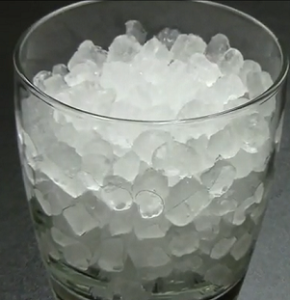 chemotherapies…the double-doozie of fludarabine (4th of 4) and melphalan. Melphalan is the chemotherapy that is likely to give Dad mouth sores, oral mucositis. These usually appear 5 – 10 days after the melphalan is received. Mucositis can then last 7 – 14 days. To minimize Dad’s risk of getting mucositis, Dad used oral cryotherapy. The idea behind the oral cryotherapy is to make the mouth cold enough that the blood vessels in the mouth constrict and reduce the amount of Mephalan in the mouth. Dad packed ice pellets into every nook and cranny of his mouth and contained them in his mouth for 75 minutes. He went through four cupfuls of ice. Dad found it to be quite the challenge. Mom claimed that Dad was screaming while his mouth was full of ice.
chemotherapies…the double-doozie of fludarabine (4th of 4) and melphalan. Melphalan is the chemotherapy that is likely to give Dad mouth sores, oral mucositis. These usually appear 5 – 10 days after the melphalan is received. Mucositis can then last 7 – 14 days. To minimize Dad’s risk of getting mucositis, Dad used oral cryotherapy. The idea behind the oral cryotherapy is to make the mouth cold enough that the blood vessels in the mouth constrict and reduce the amount of Mephalan in the mouth. Dad packed ice pellets into every nook and cranny of his mouth and contained them in his mouth for 75 minutes. He went through four cupfuls of ice. Dad found it to be quite the challenge. Mom claimed that Dad was screaming while his mouth was full of ice.
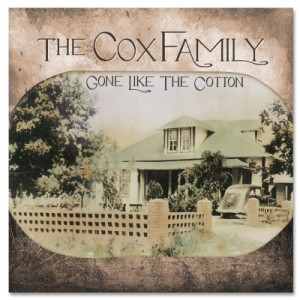 Day -1, Thursday, March 31: Dad started his “off day” with a large breakfast of french toast, sausage and donuts. It was an off day in that Dad had a day of rest. No more conditioning chemotherapies. Dad was feeling good and enjoying a new album I gave him for his birthday, Gone Like the Cotton from the Cox Family, which was produced by Alison Krausse. Dad’s favorite song on the album is “Cash on the Barrelhead.”
Day -1, Thursday, March 31: Dad started his “off day” with a large breakfast of french toast, sausage and donuts. It was an off day in that Dad had a day of rest. No more conditioning chemotherapies. Dad was feeling good and enjoying a new album I gave him for his birthday, Gone Like the Cotton from the Cox Family, which was produced by Alison Krausse. Dad’s favorite song on the album is “Cash on the Barrelhead.”
Dad walked his two miles in three phases. Later in the evening, after Dad’s bedtime shower, Husband picked up Mom so that she could get quality sleep in her own bed.
While sitting in his lounger that night, Dad experienced some tremors in both hands and arms.
 Mouth and Throat. Based upon the result of the CT scan of Dad’s brain, ENT (ear, nose & throat) was consulted to check for fungal sinusitis. ENT performed a bedside Flexible Nasal Endoscopy, which showed no evidence of a fungal infection. It did show a clear, runny nose. ENT recommended continued IV antibiotics for viral and bacterial sinusitis.
Mouth and Throat. Based upon the result of the CT scan of Dad’s brain, ENT (ear, nose & throat) was consulted to check for fungal sinusitis. ENT performed a bedside Flexible Nasal Endoscopy, which showed no evidence of a fungal infection. It did show a clear, runny nose. ENT recommended continued IV antibiotics for viral and bacterial sinusitis.
 Dad was moved to the ICU on the second floor.
Dad was moved to the ICU on the second floor.




 Day -4, Monday, March 28: This was Dad’s real birthday. He turned 76!
Day -4, Monday, March 28: This was Dad’s real birthday. He turned 76! chemotherapies…the double-doozie of fludarabine (4th of 4) and
chemotherapies…the double-doozie of fludarabine (4th of 4) and  Day -1, Thursday, March 31: Dad started his “off day” with a large breakfast of french toast, sausage and donuts. It was an off day in that Dad had a day of rest. No more conditioning chemotherapies. Dad was feeling good and enjoying a new album I gave him for his birthday,
Day -1, Thursday, March 31: Dad started his “off day” with a large breakfast of french toast, sausage and donuts. It was an off day in that Dad had a day of rest. No more conditioning chemotherapies. Dad was feeling good and enjoying a new album I gave him for his birthday,
Recent Comments